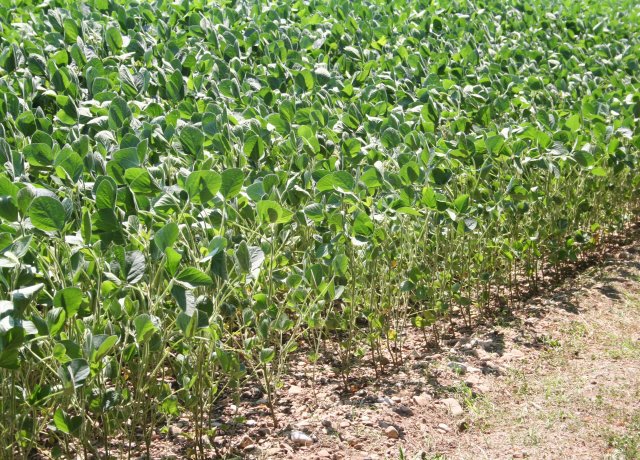2021/22 Brazil Soy 90% Planted, Dryness Developing in S. Brazil

The weather pattern in southern Brazil appears to be diverging from the weather pattern in central and northern Brazil. Southern Brazil turned dryer during the first half of November and the forecast is calling for dryer-than-normal weather for the next 15 days. In contrast, central and northern Brazil started the season with good rains and the rainfall if forecasted to remain good during December.
If the dryer forecast for southern Brazil verifies, maybe as much as 25-30% of Brazil’s soybeans could be at some level of risk from adverse weather. Weekend rains helped to improve the soil moisture especially in western Rio Grande do Sul and western Parana. I currently have a neutral bias for the Brazilian soybean estimate, but if there is another one or two weeks of dry weather in southern Brazil, I could switch to a neutral to lower bias.
The 2021/22 soybean crop in Brazil was 90% planted as of late last week compared to 87% last year and 86% average according to AgRural. This represented an advance of 4% for the week. The soybeans that are left to plant are in Rio Grande do Sul and in northeastern Brazil. The early soybean harvest will start in parts of Mato Grosso before the end of December.
Mato Grosso – The Mato Grosso Institute of Agricultural Economics (Imea) reported last week that soybean planting in the state had essentially been completed and the crop was well established. Some of the earlier planted soybeans are flowering and starting to set pods.
Embrapa indicated that to complete the soybean cycle in Mato Grosso, the crop needs 450-800 mm of precipitation (18-32 inches) depending on the variety. Rainfall and temperatures have been favorable over most of the state thus far. The metrological firm TempoCampo is forecasting that the state will receive 200-300 mm (8-12 inches) during the month of December. If that forecast verifies, the state of Mato Grosso could be well on its way to producing a record soybean crop in 2021/22.
In the municipality of Nova Mutum in south-central Mato Grosso, farmers would like to see a break in the wet weather so they could apply needed insecticides. The president of the Rural Union of Nova Mutum/MT feels the crop has the potential for yields of 60 sacks per hectare (53.6 bu/ac) and that the harvest will start at the end of December for farmers who will plant safrinha cotton and in January for farmers planning to plant safrinha corn.
Parana – The soybeans in Parana were 97% planted as of earlier last week according to the Department of Rural Economics (Deral). The soybeans were 4% germinating, 86% in vegetative development, and 10% flowering. The soybean crop was rated 5% average and 95% good.
In the municipality of Sao Joao in southern Parana, the soybeans that were planted during the second half of September had good germination and the crop is developing fine. Soybeans planted during October encountered excessive rain that resulted in poor germination and some of those fields will have to be replanted.
The president of the Rural Union of Sao Joao/PR estimates that some of the most impacted fields will lose approximately 20% of its potential yield. Additionally, the end of the planting window for safrinha corn in the region has been moved forward from February 28th to January 31st. Some of the later planted soybeans will not be mature in time to plant safrinha corn, so they will probably plant winter wheat instead. In those cases, farmers are looking to return their corn seed and some of their inputs.
Farmers in the municipality are forward contracting their soybeans for R$ 160 per sack ($13.45 per bushel) for March delivery.
Rio Grande do Sul – Rio Grande do Sul is one of the last areas to plant soybeans in Brazil and recent dry weather has hindered germination and plant development. Statewide, the soybeans are 68% planted and some areas may need to be replanted due to poor germination. Recent soybean planting has been slowed as farmers wait for additional soil moisture to insure adequate germination.
Some areas of northwestern Rio Grande do Sul had gone as much as 40 days without rain until they received 0.5 to 1.0 inches of precipitation late last week and over the weekend. Farmers are reporting that some of the soybean seed had not germinated due to lack of soil moisture and others are reporting that the small soybeans are wilting. The weekend rains should give some temporary relief to the dryness.
Mato Grosso do Sul – The soybean planting in the state is in the final stages and the crop development has been good. The state generally received less than an inch of rain over the weekend.
Goias – The soybeans are 94% planted and the planting was slowed in some areas due to excessive rainfall. The crop development could be negatively impacted in the part of the state that received heavy rain and a lack of sunshine.
Minas Gerais – The rains arrived early in the state and the soybeans are 95% planted. The soybean planting progressed quickly due to the good conditions and the crop development is considered good.
Read also
Wheat in Southern Brazil Impacted by Dry Weather and Frosts
Oilseed Industry. Leaders and Strategies in the Times of a Great Change
Black Sea & Danube Region: Oilseed and Vegoil Markets Within Ongoing Transfor...
Serbia. The drought will cause extremely high losses for farmers this year
2023/24 Safrinha Corn in Brazil 91% Harvested
Write to us
Our manager will contact you soon



